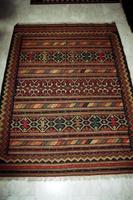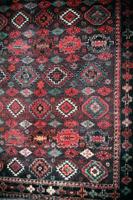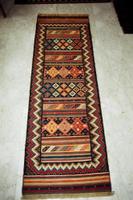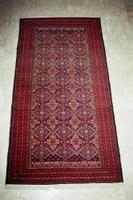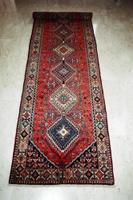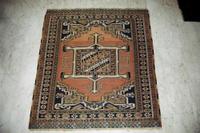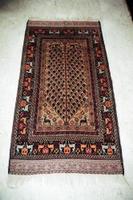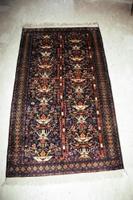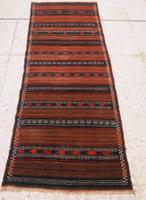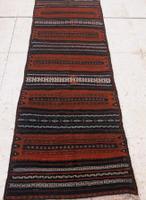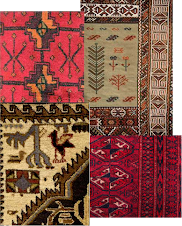Thursday, June 03, 2010
We're packing up again...
We also have the usual range of gift items, such as camel bone boxes and frames with miniature paintings, jewellery from Iran (and Indonesia), and mounted (and some framed) photos of old architecture in Bahrain.
As usual our stock is available for viewing on the internet - but you can just give us a call any other time and pop over when convenient.
There will also be one more Ethnic Art coffee morning on Sunday, June 20, before the summer hits!
Sunday, November 15, 2009
Photos of Bahrain
We are now gearing up for the Christmas holiday season, and will have tables at both the AWA Bazaar in Awali on 5th December and St. Christopher's School Fair on 11th December. So look out for us with some of these photos for sale, together with a collection of persian camel-bone miniature paintings, and persian and indonesian jewellery.
Sunday, January 18, 2009
Wednesday, September 24, 2008
New items
http://picasaweb.google.co.uk/tribalcarpets/SofrehKhorjinAndTascheSept2008# - To give you a rough idea on prices the sofreh (square kilims) are between US$400-500. The large and very unique khorjin (open saddlebags) with kilim, embroidery & carpet techniques are between $1000 – 1100. The small khorjin (bags) are between $130-350. The tasche (open bags) are between $400-560.
http://picasaweb.google.co.uk/tribalcarpets/ZollanvariBalootchSoumak# - these are from Zollanvari, the best quality producer in Iran. These will sell for roughly $580-640 per sqm.
If you are interested in any item, please let me know photo number and I can give exact price and dimensions, etc.
Wednesday, April 09, 2008
New shipment in
Monday, February 04, 2008
Real silk or fake?
Here's a copy of a recent email I received from a usergroup which covers how to test for real silk. (There's a link over on the right side panel to an article which covers this subject also).
Tests for Silk
OK, you're looking at a nicely woven, nicely patterned, closely clipped
"silk" rug with what appears to be real silk fringe. You still might be
looking at a rug made of artificial silk. Here are three field tests that
might help you distinguish real from fake. No guarantee; your mileage may
vary.
Rub it! It is sometimes claimed that you can tell real silk from artificial
silk by vigorously rubbing the pile with your open palm. The real silk rug
feels warm, the artificial silk rug stays cool to the touch. We sometimes
think we have felt this difference. Of course, it helps to have a real silk
rug with you so that you can compare a known quantity!
Burn it! This test is at least good theatre, and actually can be helpful.
Clip off a small piece of the fringe, or pull a knot out of the rug from
the back (why should the owner object?). Burn it. Look at the ash and smell
the smoke. If the material was cellulose (rayon), the ash should be soft
and chalky, and the smell should be like burning paper (most paper is made
of cellulose). If the sample is real silk, the burning sample should ball
to a black, crispy ash, and the smell should be of burning hair (you're
burning protein, the same stuff your hair is made of). You've got to be a
little careful with this test to avoid smelling the smoke from the match
(and to avoid igniting yourself or the rug dealer's shop).
Dissolve it! The most accurate test is one that chemically differentiates
protein from cellulose or petrochemicals. One such test: at room
temperature, mix a solution of 16 g copper sulfate (CuSO4) in 150 cc of
water. Add 8-10 g glycerine, then caustic soda (sodium hydroxide: NaOH)
until a clear solution is obtained. This solution will dissolve a small
sample of natural silk, but will leave cotton, rayon, and nylon unchanged.
also:
SILK BURNS ONLY AS FAR AS ON FIRE SOURCE, WHILE NYLON ONCE FIRED WILL BURN
UP TO END.... AND MORE IMPORTANT WHEN SILK BURNS, IT SMELLS LIKE A BURNED
INSECT.
Take a container of bleach put a little into the cap....take a fiber and
place it in the bleach....if it disappears within about 20 seconds its
probably silk. If it is still there after 5 min...you know its not
silk...the color of course will change, but the fiber will still be there.
It is not 100% conclusive but its fast and inexpensive
From the ASCR Fiber & Fabric Forensics class textbooks:
- A 5% concentration of sodium hypochlorite @ 20 degrees C, will dissolve
silk in 20 minutes.
- A 60% concentration of sulfuric acid @ 20 degrees C, will dissolve silk
in 20 minutes.
- Silk will also dissolve in solutions of zinc chloride, calcium chloride,
alkali thiocyanates, and ammoniacal solutions of copper or nickel.
J. Burke, C.R.N.
( Certifiable Rugnut )
www.rugmates.com
Sunday, December 09, 2007
Open for business in January

Saturday, May 26, 2007
Persian Tribal Carpets moving to Bahrain
We're moving to Bahrain during the summer, which means for the first time we're having a sale. We'll be setting up again in Bahrain, but to reduce the amount of stock we'll be shipping to Bahrain, now's your chance to get a good deal!
UPDATE: Now established in Bahrain in a villa near St Christophers in Saar. Drop us an email if you're interested in viewing and we can provide a map, etc.
Saturday, January 20, 2007
More items in stock
 Here's the staff showing off some of the new items in stock. I've also uploaded 24 items on the flickr website.
Here's the staff showing off some of the new items in stock. I've also uploaded 24 items on the flickr website.
Sunday, November 19, 2006
Miniature paintings
The major news is that we have now branched into other collectible art treasures. We're now stocking miniature paintings on camel bone - small and medium sized camel bone boxes, match boxes, eyeliner pots ("sorme don") and framed paintings. Our supplier's website in Iran is http://www.parsianart.com/ particular item you're interested in. If there is any drop us a line with t
 he it
he it em
em number
number and we can give you the price and whether we have it i
and we can give you the price and whether we have it i n
n  s
s tock.
tock.





Monday, October 30, 2006
Check out Kuwait Airport magazine
You'll also find some of my other holiday snaps in the mag.
Tuesday, August 08, 2006
New shipment in
Another shipment of tribal carpets has arrived from
This shipment features some old Qashqai / Shirazi and Luri carpets in various sizes, Yalameh carpets and Balouch prayer rugs, new wool & silk carpets from Sarakhs and Quchan, Kurdish kapan kilims (the Kurds of Khorassan region’s horse blankets), and various small kilim bags.
** UPDATE: Some photos are on my Flickr website, www.flickr.com/photos/tribalcarpets, which appears now to be unblocked if you are using Fastelco.
If you are interested in viewing in person please drop me an email tribalcarpets@gmail.com.
I’m also off to
I’ll also be popping down to
Monday, April 24, 2006
The Sayahi Dye Plant near Shiraz
All the customers, including some of the major producers in Iran such as Davardashti, supply their own wool to be dyed and then specify colours and quantities. The variations in colours are vast depending often on the length of time in the vat to get the right shade. They will also specify whether they want 100% vegetable dye or a mix with synthetic dyes to bring the cost down. Unfortunately, as the vegetable dying process takes longer, the raw materials are more difficult to obtain and are more expensive, this means that producers will often cut corners to obtain cheaper dyed wool. In some cases, synthetic dyes are necessary, such as with the use of indigo, as there is not enough natural indigo available and as natural and synthetic indigo are the same chemical compound, the end result is indistinguishable.
Mordants are used in the dying process as a ‘metal’ that binds to the wool and then binds the dye to the wool. If not done, the dyes will run out in the first wash.
Some of the natural raw materials used include madder root for red, however, as I mentioned above, it is often mixed with synthetic red to bring the cost down. Cochineal is used for burgundy reds. Wild dill is used for light yellow. Pomegranate skins and oak acorn skins are also used. The warehouse had sacks upon sacks of these natural raw materials. More photos of the dye plant can be found here.
I was particularly interested in finding out more about the washing process. A lot of commercially produced carpets use acids and alkaline solutions to soften the new carpet colours, which is unnecessary if carpets are left in the sun instead. The use of acid or alkaline washes is often called ‘medical’ washes, and is often undertaken in the winter months (when there’s not as much sun available). These washes will give carpets a soft and silky sheen, but will of course reduce the life of the wool. Tea stain, which is another common ‘wash’ effect on carpets to make them look older, lightens in time, but of course over time, carpets acquire a patina of age anyway, hence taking over from the tea wash effect.
It is possible to dye wool before spinning it. However, in most cases, wool is spun then dyed. Wool can be washed before dying to ensure the wool is cleaner, however, often this is skipped in the process. Synthetically dyed wool tends to be cleaner, as vegetable dyes leave a residue in the wool and weavers often complain of the ‘dirtiness’ of the wool. So, not only do producers have to be convinced of the benefits of using vegetable dyes, but often the weavers themselves.
In terms of the quality of wool, the local Fars wool is considered the best quality, followed by wool from the Kurdistan region.
Parham gave me a tip for checking whether wool has been dyed with vegetable or synthetic dyes. Dip a strand of wool in a hydro sulphate solution. If the colour fades quickly it will confirm the use of synthetic dyes.
Here are some photos:
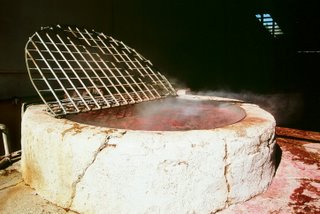
A dye vat - wool being dyed red with madder root
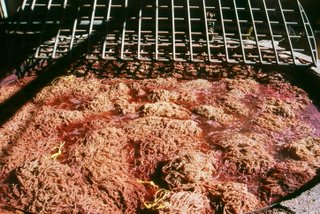
Wool in the dye vat
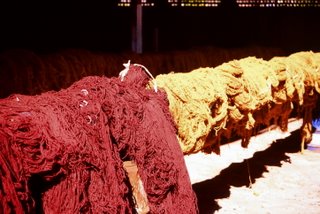
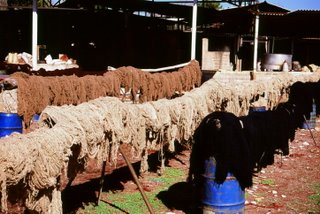
Dyed wool drying in the sun
Saturday, March 18, 2006
Gabbeh weaving in the Chahar Mahal
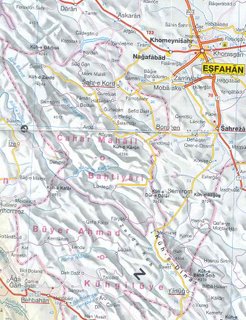 On my last buying trip to Iran I stayed with a Qashqai producer in Borujen, Godarz Hoshmand Emanlou, and went with him to visit some of the 100-odd weavers he has producing gabbeh carpets in the mountain villages in this area. He dyes all the wool himself, using vegetable dyes, which he then provides to the weavers. He also provides them with the designs to weave based on his knowledge of what the market wants. The weavers are paid for the product off the loom. Each week Godarz makes a trip to a dealer in the Tehran bazaar who buys the product and will finish the carpets for sale, i.e. shear the pile and wash the carpet. The weavers are all from Bakhtiari villages, though the gabbehs when they reach the markets in Esfahan, Shiraz or Tehran will probably be known as Qashqai gabbeh weavings.
On my last buying trip to Iran I stayed with a Qashqai producer in Borujen, Godarz Hoshmand Emanlou, and went with him to visit some of the 100-odd weavers he has producing gabbeh carpets in the mountain villages in this area. He dyes all the wool himself, using vegetable dyes, which he then provides to the weavers. He also provides them with the designs to weave based on his knowledge of what the market wants. The weavers are paid for the product off the loom. Each week Godarz makes a trip to a dealer in the Tehran bazaar who buys the product and will finish the carpets for sale, i.e. shear the pile and wash the carpet. The weavers are all from Bakhtiari villages, though the gabbehs when they reach the markets in Esfahan, Shiraz or Tehran will probably be known as Qashqai gabbeh weavings.In fact, there are many falsehoods in the carpet weaving business which makes it extremely difficult to know what you're buying as an end customer. One story retold to me when I passed through one particular village is that locally this village has an excellent reputation for its gabbeh carpets, yet Shirazi dealers fail to believe that this poor mountainous village could possibly deliver such excellent weaving, so they are sold as "Bushehr" gabbeh carpets -"Bushehr" having the reputation in the major carpet centres within Iran as having the best quality.
Here are some photos...
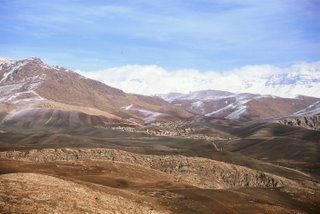
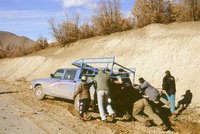 This is a very mountainous region, and visiting in January there was a lot of snow around. The villages are mostly unpaved, which meant wading through lots of mud. We even managed to get our vehicle stuck in the mud when we veered off the tar-sealed road.
This is a very mountainous region, and visiting in January there was a lot of snow around. The villages are mostly unpaved, which meant wading through lots of mud. We even managed to get our vehicle stuck in the mud when we veered off the tar-sealed road. 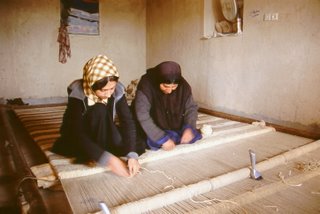
Mother and daughter weaving an undyed striped gabbeh carpet in Sarmour village. The carpet behind them represents 22 days work so far.
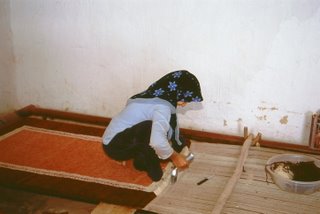 A 16 year old girl doing some of the weaving on a fine quality gabbeh carpet that is mostly the work of her older 24 year old sister.
A 16 year old girl doing some of the weaving on a fine quality gabbeh carpet that is mostly the work of her older 24 year old sister.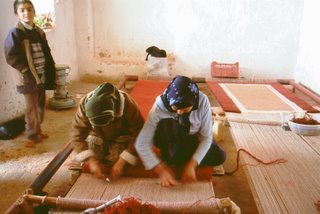
The same girl with her younger 8 year old sister weaving a plain red gabbeh runner size carpet. For these families, the bulk of their income comes from the girl's weaving in this subsistence farming area in the mountains. The reality is the better the weaving skills of the womenfolk, the greater the income they can expect. The older 24 year old sister who has been weaving for 12 years is in much demand by other gabbeh carpet dealers/producers.
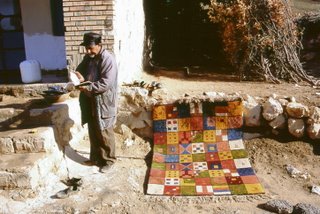
This is one of the finished carpets being paid for. (The weaver was too shy to appear in front of the camera!)
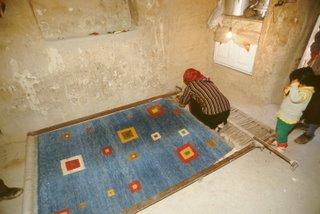
A completed carpet being cut from the loom.
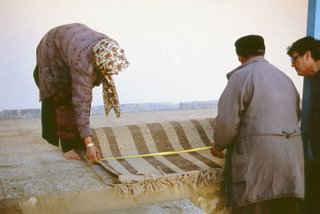
A carpet being measured - payment for the weaver is per square cm.
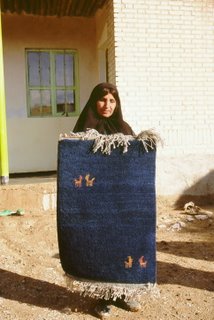
A carpet that was made on spec. by the weaver.
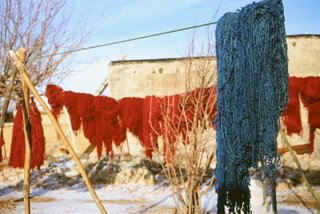
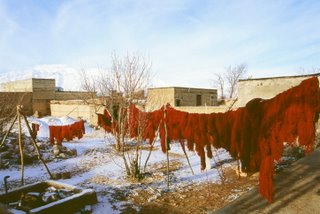
Naturally died wool drying in the sun. The madder root is used for the reds, indigo for the blue. Godarz does the dyeing of all the wool himself, with an assistant, using natural vegetable dyes.
Friday, March 17, 2006
Cleaning carpets
Me: I don't suppose you can expand on your comment...
"As I'm sure you are well aware, there is a VERY right and VERY wrong way
to treat vegetable dyed fine wool rugs! An incorrect approach could be disastrous!"Here in the Middle East we vacuum carpets, then wash them every few years when they require it, by lightly scrubbing with a wet brush and some soap solution that doesn't have any nasty chemicals in it (some use olive oil soap, some baby shampoo), then rinse with cold water and leave out in the sun to dry. This is what they do in Iran, or some I'm told by all the dealers I buy from.
The cleaning expert: The cleaning methods that you have alluded to (using water and mild soap) are just fine. As long as the color-fastness of the dyes are tested prior to actually washing the rug. The main problem with so many "so called experts" that claim to be able to clean fine rugs is that so many cleaners attempt to use the same types of chemicals and detergents (alkaline chemicals) that they used when cleaning synthetic fibers (such as nylon). This can cause severe damage to wool fibers. Alkaline chemicals should NEVER be used on wool. Nor should any types of stain guards (Tefflon, StainMaster, etc.) ever be used. Wool fibers are permeated with lanolin which is a natural stain guard. No other types of stain guards are necessary.
It is also important that wool rugs not be "overcleaned" as the cleaning process will actually tend to strip away the natural lanolin. This can leave the fibers dried out and brittle.
Finally, it is very important that a wool rug be dried properly. There is certainly no harm in getting a wool rug wet (providing that the dyes are stable and will not bleed). After all, sheep stand out in the rain! But the rug should be dried as much as possible and as quickly as possible. For this it is important that extraction equipment is used along with blowers and dehumidification equipment.
It is not hard to clean wool rugs. But far too often there are carpet cleaning companies that are trying to expand their business and attempt to clean fine wool (and silk) rugs, not realizing that their cleaning methods are actually damaging these rugs! I know this because we VERY OFTEN receive rugs to repair that have been damaged by these self-proclaimed "experts".Sincerely,
Chris Howell
Color Your Carpet
http://www.colorcarpet.com/
(301) 776-2393
Wednesday, March 08, 2006
New shipment in
Drop us an email to arrange a time to view at tribalcarpets@gmail.com.
Tuesday, January 17, 2006
Some silk carpets
UPDATE: 13 Feb - shipment still hasn't left Iran, but is expected on this Saturday's flight from Isfahan...
Tuesday, December 20, 2005
Photos updated on Flickr
I'm making another buying trip early January, so watch this space.
Wednesday, October 05, 2005
New shipment of carpets & kilims (part II)
Friday, July 15, 2005
New shipment of carpets & kilims
Friday, July 01, 2005
Persian Tribal Carpets on Flickr
Monday, June 27, 2005
Saturday, May 28, 2005
Baktiari saddle bag
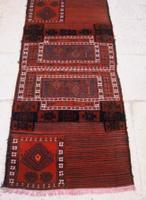
This is a large Baktiari saddle bag that was used for many years by nomads on their yearly migrations. It has been opened out stitched in the middle to give a symetrical kilim/carpet/embroidery work to lay on the floor or hang on the wall.
Item no. 38
Origin: Bakhtiari
Price: KD 120
Size: 244 x 112cm
Material: 100% wool
Thursday, May 26, 2005
Persian Tribal Carpets available in Kuwait
Please look through the inventory of carpets on our Flickr photo website and if something appeals, drop us an email with the reference number. If you don’t see anything that is quite what you’re looking for – e.g. you’re looking for a certain pattern, style, carpet from a particular region, or the colours aren’t quite right - let us know. We have a number of sources in Iran where we can obtain, hopefully, the right carpet or kilim to fit in with your décor. If you’ve got the time, we can probably even get a new carpet made to order.
We will endeavor to keep the items for sale up to date on the Flickr site, but stock can move pretty quickly at times, so please forgive us if the item you are interested in has gone before we get to update the page. Sold items will be indicated, but you can look at these for ideas of the sorts of rugs and kilims that were previously available (and if you find something you particularly like we can try to order in something similar).
We offer a range of carpets and kilims at various sizes and price points, ranging from authentic nomadic weavings, i.e. woven by nomadic women, to weavings based on nomadic or tribal designs made in the villages and towns of Iran, invariably from tribes that have given up their nomadic existence but continue to keep the traditions of carpet weaving alive.
And in a unique move for this part of the world, all prices are fixed at good value prices. So, no more haggling over prices with a shrewd salesman in the bazaar, who will spin you any old yarn to make a sale. Or maybe you don’t really know the value of the item you are negotiating for anyway, and you find out later you’ve been ripped off.
Please send us an email at tribalcarpets@gmail.com if you are interested in purchasing any of the carpets or kilims, or to get instructions on where to find us. Alternatively you can leave comments against particular carpets and kilims for other users to view.





